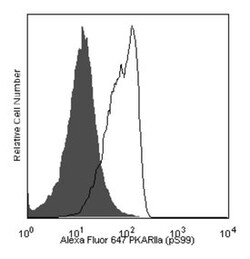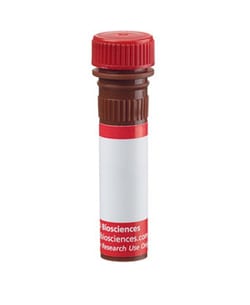Learn More
PKA RIIα (pS99) Mouse anti-Human, Alexa Fluor 647, Clone: I65-856.286, BD
Mouse Monoclonal Antibody
Supplier: BD Biosciences 560164
Description
cAMP-dependent Protein Kinase (PKA) is composed of two distinct subunits: catalytic (C) and regulatory (R). Four regulatory subunits have been identified: RIα, RIβ, RIIα, and RIIβ. These subunits define type I and II PKAs. Following binding of cAMP, the regulatory subunits dissociate from the catalytic subunits, rendering the enzyme active. Type I and II holoenzymes have three potential C subunits (Cα, Cβ, or Cγ). Type II PKA can be distinguished by autophosphorylation of the R subunits, while type I PKA binds Mg/ATP with high affinity. The cAMP-dependent autophosphorylation of the human RIIα subunit occurs at Serine 99 (S99) (Entrez Protein Accession No.CAA33094). Most cells express both type I and type II PKAs. Although the Rα isoforms are ubiquitously expressed, the Rβ isoforms are predominantly found in nervous and adipose tissues. In addition to their enzyme regulatory activity, the RIIα and RIIβ subunits determine the subcellular location of the holoenzymes via their interactions with specific intracellular anchoring proteins. The I65-856.286 antibody recognizes human PKA RIIα phosphorylated at S99.
Host Species: Mouse
Clone: I65-856.286
Isotype: IgG1 κ
Species Reactivity: Human
Immunogen: Phosphorylated Human PKA RIIα Peptide
Intracellular Staining

Specifications
| PKA RIIα (pS99) | |
| Monoclonal | |
| Alexa Fluor 647 | |
| Mouse | |
| Affinity Purified | |
| RUO | |
| Primary | |
| Store undiluted at 4°C and protected from prolonged exposure to light. Do not freeze. |
| Flow Cytometry | |
| I65-856.286 | |
| Aqueous buffered solution containing BSA and ≤0.09% sodium azide. | |
| Phosphorylated Human PKA RIIα Peptide | |
| 50 Tests | |
| Cell Biology | |
| Human | |
| IgG1 κ |
Safety and Handling
Your input is important to us. Please complete this form to provide feedback related to the content on this product.


